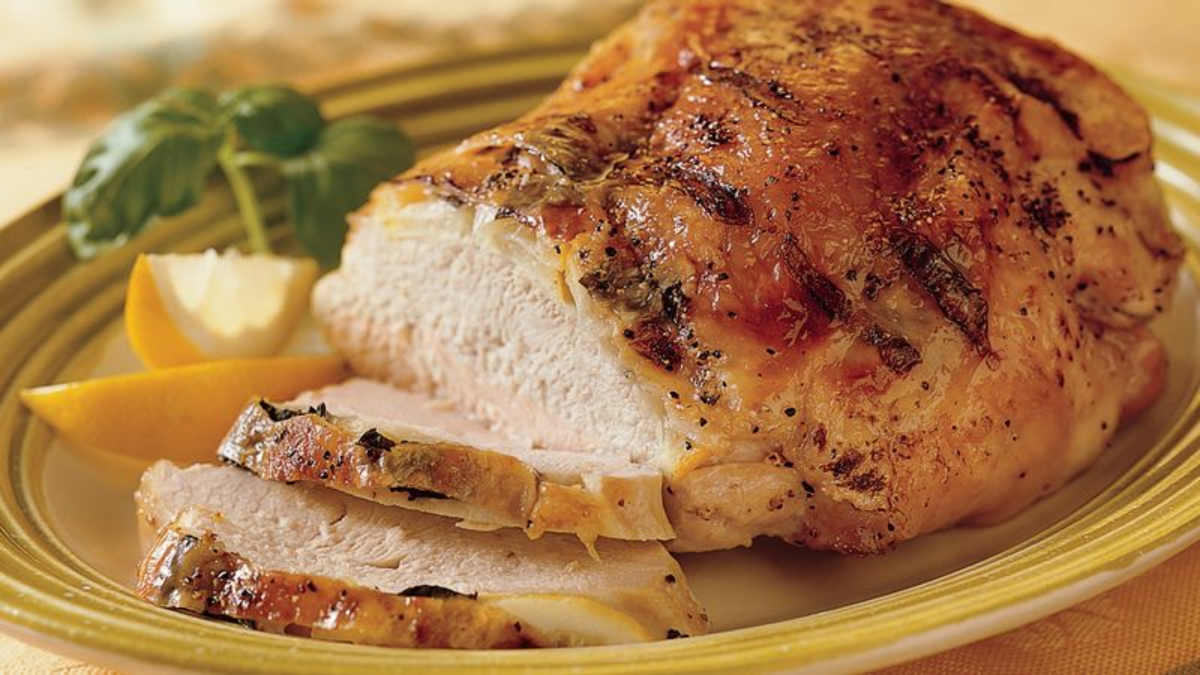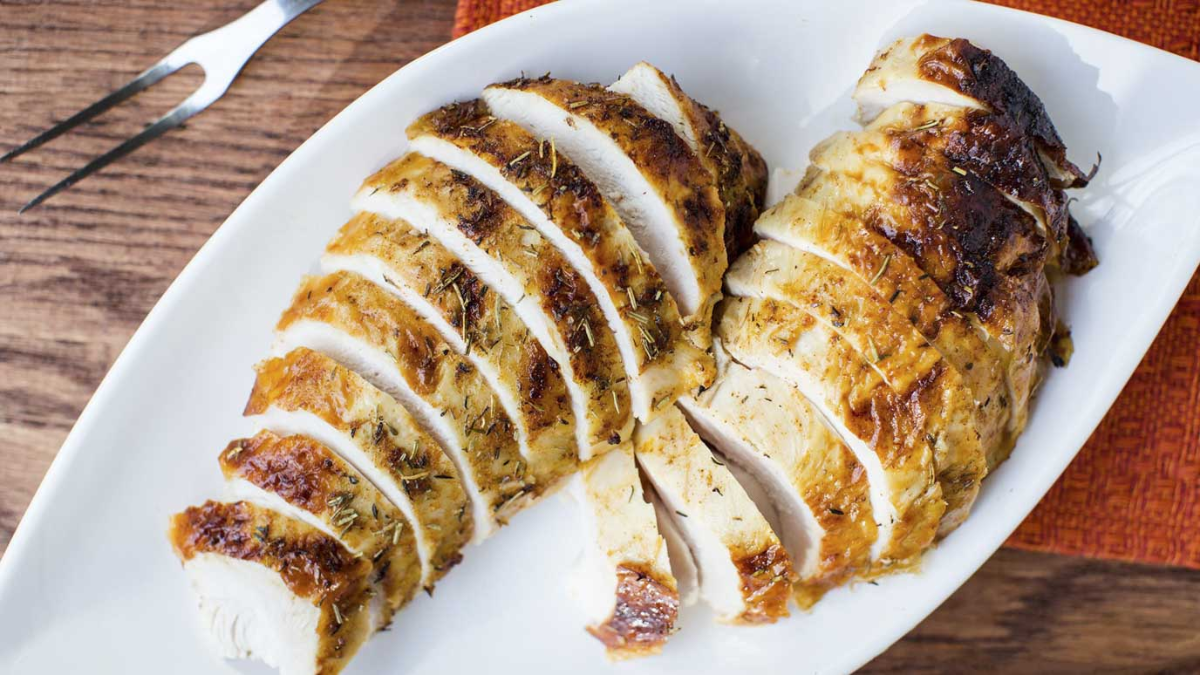A straightforward, hassle-free recipe for a grilled turkey breast that’s ideal for your little event! Grilling a simple turkey breast you must prepare this, so fire up the grill! A turkey breast is a wonderful alternative for a Sunday night supper or a smaller holiday gathering. A whole turkey on the grill can be more than you need or desire. Try grilling a turkey breast instead of a standard whole turkey to avoid having a fridge full of leftovers. A turkey breast is great for 4-6 people and cooks considerably faster than a traditional whole turkey.
Additionally, turkey has several health advantages, especially when used with red meat. Use an excellent meat thermometer whether you are grilling or roasting any meat. You can never go wrong when using a thermometer to determine whether your meat is done. Indirect grilling is the best method for properly cooking turkey breast without scorching it, and this indicates that you cook the meat over a section of the grill that is not lit.
Turkey Breast Nutrition Facts
Turkey Breast
The turkey’s chest is where the meat from a turkey breast comes from. Only this substantial portion of the bird’s meat is white. This results in a higher price per pound than a whole turkey, but it also makes it simpler to handle and store. Turkey breast has a deeper chicken breast flavor, and its soft, succulent texture is accompanied by a subtle, savory flavor and a hint of sweetness.
This cut goes well with flavorings like spice rubs and herb butter and traditional holiday sides like turkey gravy, cranberry sauce, and stuffing made with components like celery and sage. Mayonnaise and mustard are common condiments when meat is roasted or smoked, then cut for sandwiches.
How to Grill Turkey Breast?
Here is the best grilled boneless turkey breast recipe:
Equipment
-
Brick
-
Gas Grill
Ingredients
- 1 ½ cups of your favorite beer
- ⅓ cup Kosher salt
- 1 cup whole milk yogurt or buttermilk can be substituted
- Three cloves of garlic minced
- One teaspoon of fresh ground pepper
- ¼ cup fresh parsley chopped
- Two tablespoons of fresh sage chopped (optional)
- Two fresh turkey breast halves
- Brick and aluminum foil (optional)
- High-temperature oil suitable for grilling
Instructions
-
In a medium mixing bowl, whisk the salt into the beer until it dissolves. Then, whisk in yogurt, garlic, pepper, parsley and sage until well combined.
-
Put raw turkey breasts in a gallon-size sealable bag and pour the brine over it. Seal the bag and rest it in a flat bottom dish, like an 8×8 pan. Put the pan in the refrigerator and marinate for 8-12 hours, flipping the bag over at least once.
-
When ready to grill, take the bag out of the fridge. Remove turkey from brine and pat dry with paper towels. Let sit at room temperature while the grill preheats. Discard brine.
-
Preheat the gas grill by turning all burners to a grilling temperature between 450° – 500° F. Wrap a brick with clean aluminum foil and place it in the grill while preheating. (Using a brick is optional but is suggested if the turkey breast doesn’t lay flat on the grill.)
-
When the grill is heated, turn off one burner, leaving at least one on. Spray or rub grill grates with oil on the OFF side only. Carefully lay turkey breasts on grill side with burners turned OFF, skin side down. Put on a heavy-duty oven mitt and place the brick on top of the turkey breasts (this step is optional). Close the grill and let cook undisturbed for about 30 minutes. Check the temperature on your grill frequently and adjust the level on the burner to keep the grill temperature around 450° F (likely, you will have to turn the burners up to a hotter temperature).
-
At 30 minutes, remove the brick while wearing the heavy-duty oven mitt and turn the turkey breast. Take the temperature of the meat in 2 places. Refer to the suggestions above in the blog post to determine the best time to remove turkey from the grill, likely when breast meat reaches 160° F. If the temperature is still reading low, grill for 5-minute increments skin side up, checking the temperature each time.
-
Let turkey breasts rest on the cutting board for 10-15 untouched. Then, slice up the meat or serve on the bone.
How to Serve Turkey Breast?
Here are some ideas for what to do with oven-roasted turkey breast:
- Turkey with mashed potatoes: For a hearty, classic meal, pair turkey breast with mashed potatoes, turkey gravy made from the pan drippings, and steamed veggies.
- Turkey noodle soup: Add shredded leftover turkey breast and noodles to chicken stock or turkey stock for a quick turkey soup.
- Turkey Salad: Turkey salad comes together easily with diced turkey breast, mayo, celery, shallots, and lemon zest. Serve over a bed of crunchy romaine and juicy tomatoes for a diner classic.
- Turkey enchiladas: Shredded turkey breast is a perfect filling for enchiladas. Fill tortillas with the turkey meat mixed with a bit of your favorite enchilada sauce, arrange in a baking dish, and pour more sauce over the top. Sprinkle generously with cheese and bake until bubbling.
- Turkey sandwiches: A turkey Reuben is a fun take on a deli staple. Layer sliced turkey breast with sauerkraut, swiss cheese, and Russian dressing between two slices of buttered rye bread, then grill on each side until the cheese has melted and the bread is nicely toasted.
What are Points to Remember While Grilling Turkey Breast?
Here are some important points to remember while grilling turkey breast:
- Temper the meat. Cooking the turkey directly from the refrigerator will cool the hot pan and create steam, causing the meat to cook unevenly. About thirty minutes before cooking the turkey, pull it from the refrigerator and let it rest at room temperature. If using frozen turkey meat, thaw completely in the refrigerator and then temper. (This is a good practice for cooking whole turkey and other cuts of meat.)
- Season generously. Turkey breast is thick compared to a chicken breast, and even seasoning is a crucial step in getting the best tasting turkey, so generously coat the bird with salt and pepper before cooking so the seasoning can permeate the meat.
- Cook directly on top of the herbs. Using a bed of whole sprigs of thyme and rosemary while cooking the turkey will perfume the meat while it cooks for that classic herb-roasted flavor.
- Use a meat thermometer. Turkey breast can easily dry out if overcooked. To prevent this, periodically insert an instant-read thermometer into the thickest part of the breast. When it reaches 160 degrees Fahrenheit, remove it from the oven and let the meat rest. The residual heat will continue cooking to 165 (the proper temperature for cooking poultry) without drying it out.
Is Eating Turkey Breast Healthy?
Eating turkey breast has a lot of health benefits:
Rich in protein
Turkey is lean meat that is a fantastic option for anyone trying to cut back on their fat intake because it is lower in fat and higher in protein than chicken. However, because it has a lot of protein and little fat, the meat might cook quickly and end up being dry. To retain moisture, various techniques, such as bringing, using fattier ingredients, and jointing the bird for more even cooking, may be helpful.
In addition to providing all nine of the essential amino acids required for growth and repair, the protein in poultry meat is of a sort that is simple for human systems to acquire and utilize.
Good Source of Vitamins B
Turkey meat is a good B vitamin family source, including vitamins B3, B6, and B12. These vitamins are essential for creating red blood cells, brain health, and energy production.
Good Source of Minerals
Turkey meat is a valuable addition since it is high in selenium, zinc, phosphorus, and iron, which help thyroid function, immunity, bone health, and energy production. The darker meat pieces, such as the leg and thigh, are higher in iron-rich elements.
Low in Fat
For quick spurts of energy like fluttering the wings and scrambling away from predators, fowl naturally have a lot of “fast-twitch” muscle in their meat. Because of this, poultry meat contains very little fat, and what little fat it does have is mostly contained in and beneath the skin.
May Support Heart Health
The low fat, high protein, and wide range of micronutrient contributions of turkey all contribute to its potential heart-health benefits. Higher diets of poultry and fish were linked to a lower risk of coronary artery disease, according to extensive observational research on females. Additionally, it appears that switching from red meat to poultry decreased the cardiovascular risk by 19%.
Is Turkey Safe for Everyone?
Unless you have a turkey allergy, this famous Christmas and Thanksgiving roast are generally safe for consumption. Though it is uncommon, allergies can affect both children and adults. It’s possible to develop a secondary allergy to poultry meat, possibly related to a sensitivity to serum albumins found in muscle and egg yolk. According to reports, chicken and turkey have a high cross-reactivity.
Processed turkeys or fresh turkey that has been brined before roasting may contain a lot of salt, additives, and flavor boosters. If you consume little salt, it’s wise to review labels or recipes.
Conclusion
This dish for grilled turkey breast is juicy, flavorful, and has crispy skin. Additionally, it looks much more quickly than a whole turkey! This recipe for grilled turkey breast is perfect for you if you’re hosting a small holiday celebration and don’t want to prepare the whole bird or enjoy white flesh. I was hoping you could continue reading to discover my insider tips for making a homemade turkey breast brine as well as how to grill a turkey breast that is flavorful and packed with flavor. Grilled turkey breast is the ideal light meal for the summer when you’re lounging in the backyard or don’t want to heat your home with the oven. A simple main dish that may be served hot or cold is grilled turkey breast.



